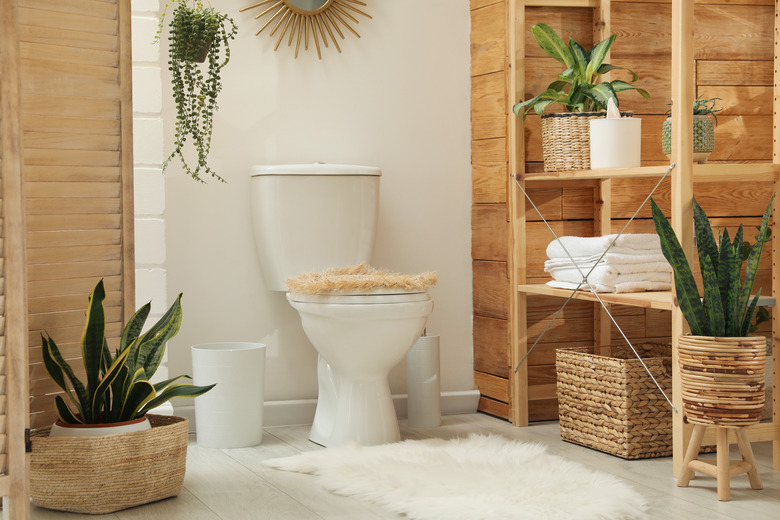How To Paint A Ceramic Toilet
We may receive a commission on purchases made from links.
If you have a porcelain toilet that is stained or you just want to jazz it up, you can paint it, but be prepared for a lengthy task. If your goal is to paint the inside of the toilet and not just its exterior, however, think again, because painting the inside of a bowl is absolutely not recommended.
Tip
When painting bathroom fixtures, you'll need a special product. This may be a two-part epoxy that you mix yourself or a spray paint.
Can You Paint a Toilet Bowl?
Can You Paint a Toilet Bowl?
You should not try to paint the inside of a toilet bowl. Obviously, paint that is constantly submerged in water, not to mention water that is "yellow till it mellows," as some municipalities recommend, will test the adherence and long-lasting properties of even the best paint. Further, peeling paint can lead to pipe blockages.
No industry experts would recommend painting the inside of a toilet bowl. However, this does not mean you can't try to paint and otherwise beautify the other parts of your toilet.
Prep the Toilet for Paint
Prep the Toilet for Paint
Toilets are shiny and smooth; that's a fact. Getting paint to adhere to a shiny surface first requires cleaning and then roughing up that surface. But first things first: cleaning solutions and ceramic-painting kits produce fumes, so open the windows and turn on your exhaust fan. Don a high-quality respirator, as well as goggles and rubber gloves.
It's time for a deep clean. Experts vary in their recommendations for how to accomplish this, but the goal is to perform the deepest clean your toilet has ever had:
- First, remove hardware and caulk.
- Then using some TSP (trisodium phosphate) and a stiff brush, scrub the sides, top, and anywhere you plan to paint. Alternatively, wipe down the toilet with a 10-percent bleach solution, followed by an abrasive cleanser like Ajax or Comet.
- Rinse thoroughly, wipe with a clean, dry towel, and let the toilet air-dry for at least two hours.
Rust-Oleum, which makes a tub-and-tile painting product, recommends then wiping down the toilet with a non-oily solvent like alcohol or acetone, then scrubbing with an abrasive pad and a product designed to remove lime, calcium, and rust, such as Lime-A-Way, which will begin to create a somewhat porous surface. Let this sit for five minutes; then scrub again. Rinse well and let dry.
You're not done yet. Now it's time to sand because you really need to completely remove the surface gloss. Using 400- to 600-grit wet/dry sandpaper, go over the whole toilet until its nice, smooth surface is rough and somewhat gritty. Rinse thoroughly with water; then let the toilet dry at least 90 minutes. Just before you start painting, wipe the toilet down with a tack cloth so all dust is removed.
Paint the Toilet
Paint the Toilet
You're finally ready to paint. Choose a product designed specifically to paint ceramic, usually marketed as "tub and tile" paint. This may come as a kit that includes TSP or a bonding primer, like the Magic Tub & Tile Refinishing Kit, a spray paint that does not require premixing. Or you might instead choose a two-part epoxy formula that requires mixing, such as Rust-Oleum's Tub and Tile Refinishing Kit. Depending on the product, you may be rolling on the paint or spraying it on. Follow the manufacturer's directions closely. These will usually direct you to apply two coats.
Tip
Most tub-and-tile products offer few color choices, coming in white, almond, or black. If you want another color, some products can be tinted, but read the directions carefully to be sure. Rust-Oleum's product, for instance, can be tinted a pastel color using a universal colorant.
